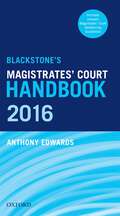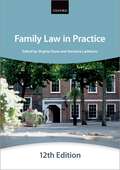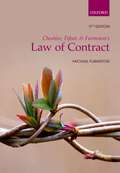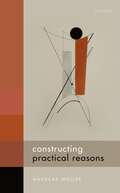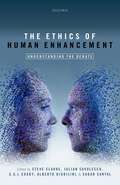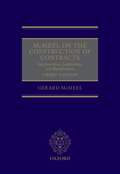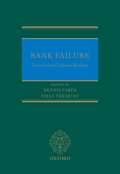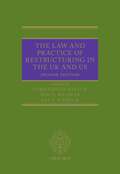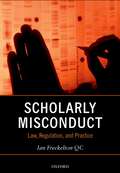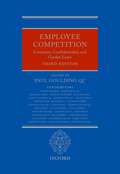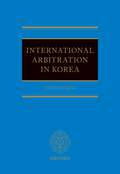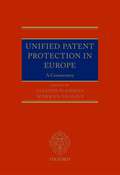- Table View
- List View
Blackstone's Magistrates' Court Handbook 2016
by Anthony EdwardsThe new edition of the bestselling Blackstone's Magistrates' Court Handbook provides a complete practical guide for the busy practitioner. Incorporating essential extracts from the Magistrates' Court Sentencing Guidelines, it offers all you need in one trustworthy source. Covering all the key aspects of magistrates' court practice, the book focuses on the areas most likely to arise at short notice requiring an instant response from the advocate, as well as on those offences most frequently experienced at court, such as public order, dishonesty, drugs, weapons, driving, criminal damage, and sexual offences. Blackstone's Magistrates' Court Handbook's easy-to-use pocket-sized format facilitates quick reading and instant decision-making. Tables, flow-charts, and a clear system of icons aid comprehension and speedy navigation. Cross-referencing to Blackstone's Criminal Practice 2016 provides you with easy access to in-depth commentary.
Family Law in Practice (Bar Manuals)
by The City Law SchoolAlmost all junior barristers in civil practice are likely to encounter family law work in their first years of practice. Family Law in Practice provides a detailed introduction to the key areas of the substantive family law of which the junior practitioner should have a good working knowledge. Key aspects of family law covered include domestic violence, care proceedings and pre-nuptial agreements. Adopting a highly pragmatic approach, Family Law in Practice encourages students to build on their existing basic practitioner skills, and highlights how to approach writing opinions and drafting documents specific to family law. It provides invaluable practical advice on how to prepare for different types of hearing, what factors to consider in relation to negotiation, how to make persuasive submissions, and how to handle witnesses effectively, ensuring that the junior practitioner is fully prepared for his or her first steps in the family courts.
Cheshire, Fifoot, and Furmston's Law of Contract
by MP FurmstonCheshire, Fifoot & Furmston's Law of Contract remains one of the leading textbooks on contract law more than 70 years after the publication of its first edition. It combines a clear and authoritative account of the principles of the law of contract with thought-provoking analysis and insights. - The clarity of the narrative and lucid writing style helps to bring understanding of complex issues to a wider readership - Each topic is clearly signposted with summaries, introductory text and sub-headings for ease of navigation throughout the book - Numerous references to additional primary and secondary sources take the reader even further into the subject
Cheshire, Fifoot, and Furmston's Law of Contract
by MP FurmstonCheshire, Fifoot & Furmston's Law of Contract remains one of the leading textbooks on contract law more than 70 years after the publication of its first edition. It combines a clear and authoritative account of the principles of the law of contract with thought-provoking analysis and insights. - The clarity of the narrative and lucid writing style helps to bring understanding of complex issues to a wider readership - Each topic is clearly signposted with summaries, introductory text and sub-headings for ease of navigation throughout the book - Numerous references to additional primary and secondary sources take the reader even further into the subject
Constructing Practical Reasons
by Andreas MüllerSome things are reasons for us to perform certain actions. That it will spare you great pain in the future, for example, is a reason for you to go to the dentist now, and that you are already late for work is a reason for you not to read the next article in the morning paper. Why are such considerations reasons for or against certain actions? Constructivism offers an intriguing answer to this question. Its basic idea is often encapsulated in the slogan that reasons are not discovered but made by us. Andreas Müller elaborates this idea into a fully-fledged account of practical reasons, makes its theoretical commitments explicit, and defends it against some well-known objections. Constructing Practical Reasons begins with an examination of the distinctive role that reason judgements play in the process of practical reasoning. This provides the resources for an anti-representationalist conception of the nature of those judgements, according to which they are true, if they are true, not because they accurately represent certain normative facts, but because of their role in sound reasoning. On the resulting view, a consideration owes its status as a reason to the truth of the corresponding reason judgement and thus, ultimately, to the soundness of a certain episode of reasoning. Consequently, our practical reasons exhibit a kind of mind-dependence, but this does not force us to deny their objectivity.
Constructing Practical Reasons
by Andreas MüllerSome things are reasons for us to perform certain actions. That it will spare you great pain in the future, for example, is a reason for you to go to the dentist now, and that you are already late for work is a reason for you not to read the next article in the morning paper. Why are such considerations reasons for or against certain actions? Constructivism offers an intriguing answer to this question. Its basic idea is often encapsulated in the slogan that reasons are not discovered but made by us. Andreas Müller elaborates this idea into a fully-fledged account of practical reasons, makes its theoretical commitments explicit, and defends it against some well-known objections. Constructing Practical Reasons begins with an examination of the distinctive role that reason judgements play in the process of practical reasoning. This provides the resources for an anti-representationalist conception of the nature of those judgements, according to which they are true, if they are true, not because they accurately represent certain normative facts, but because of their role in sound reasoning. On the resulting view, a consideration owes its status as a reason to the truth of the corresponding reason judgement and thus, ultimately, to the soundness of a certain episode of reasoning. Consequently, our practical reasons exhibit a kind of mind-dependence, but this does not force us to deny their objectivity.
The Ethics of Human Enhancement: Understanding the Debate
We humans can enhance some of our mental and physical abilities above the normal upper limits for our species with the use of particular drug therapies and medical procedures. We will be able to enhance many more of our abilities in more ways in the near future. Some commentators have welcomed the prospect of wide use of human enhancement technologies, while others have viewed it with alarm, and have made clear that they find human enhancement morally objectionable. The Ethics of Human Enhancement examines whether the reactions can be supported by articulated philosophical reasoning, or perhaps explained in terms of psychological influences on moral reasoning. An international team of ethicists refresh the debate with new ideas and arguments, making connections with scientific research and with related issues in moral philosophy.
The Ethics of Human Enhancement: Understanding the Debate
by Steve Clarke Julian Savulescu Alberto Giubilini Sagar Sanyal Tony CoadyWe humans can enhance some of our mental and physical abilities above the normal upper limits for our species with the use of particular drug therapies and medical procedures. We will be able to enhance many more of our abilities in more ways in the near future. Some commentators have welcomed the prospect of wide use of human enhancement technologies, while others have viewed it with alarm, and have made clear that they find human enhancement morally objectionable. The Ethics of Human Enhancement examines whether the reactions can be supported by articulated philosophical reasoning, or perhaps explained in terms of psychological influences on moral reasoning. An international team of ethicists refresh the debate with new ideas and arguments, making connections with scientific research and with related issues in moral philosophy.
Copyright User Rights: Contracts and the Erosion of Property
by Pascale ChapdelaineThis is the first book to offer an in-depth investigation of the unsettled nature, scope and dynamics of copyright user rights in an increasingly dematerialized environment. Combining a detailed theoretical framework with practical applications, the book provides a comprehensive perspective on copyright user rights, exploring the nature of commercial copies of copyright works, of exceptions to copyright infringement, and how they are shaped to a large extent by traditional concepts of private law (e.g. property, goods, services, sales, and licences). Using property and contract law and theory, it addresses the competing interests of copyright holders and users in the same object, and points out the double standards in how the rights of copyright holders and copyright users are dealt with. It argues that the property component of user rights has been largely neglected and needs to be brought to the fore, to give the protection that users deserve, without neglecting the rights users should have as they increasingly experience copyright works through services. With the onset of an increasingly digital age, it emphasises how traditional concepts of private law need to adapt for adequately dealing with the dematerialization of copies of copyright works and user rights. It proposes a clearer view on the justification and nature of user rights, with possible gradations of powers for users, and suggests how courts and legislatures may address contract terms that weaken user rights. This book provides vital tools for law- and policy-makers worldwide who seek to achieve the proper balance between the competing rights and interests of copyright holders, copyright users, and the public domain.
Copyright User Rights: Contracts and the Erosion of Property
by Pascale ChapdelaineThis is the first book to offer an in-depth investigation of the unsettled nature, scope and dynamics of copyright user rights in an increasingly dematerialized environment. Combining a detailed theoretical framework with practical applications, the book provides a comprehensive perspective on copyright user rights, exploring the nature of commercial copies of copyright works, of exceptions to copyright infringement, and how they are shaped to a large extent by traditional concepts of private law (e.g. property, goods, services, sales, and licences). Using property and contract law and theory, it addresses the competing interests of copyright holders and users in the same object, and points out the double standards in how the rights of copyright holders and copyright users are dealt with. It argues that the property component of user rights has been largely neglected and needs to be brought to the fore, to give the protection that users deserve, without neglecting the rights users should have as they increasingly experience copyright works through services. With the onset of an increasingly digital age, it emphasises how traditional concepts of private law need to adapt for adequately dealing with the dematerialization of copies of copyright works and user rights. It proposes a clearer view on the justification and nature of user rights, with possible gradations of powers for users, and suggests how courts and legislatures may address contract terms that weaken user rights. This book provides vital tools for law- and policy-makers worldwide who seek to achieve the proper balance between the competing rights and interests of copyright holders, copyright users, and the public domain.
McMeel on The Construction of Contracts: Interpretation, Implication, and Rectification
by Gerard McMeelNow in its third edition, this authoritative work on the construction of contracts is an invaluable resource for legal practitioners and academics seeking to understand the legal principles involved in contract interpretation as well as the current trends in the neighbouring topics of implied terms and rectification. The third edition continues its principle-by-principle coverage of the main elements of contractual construction with reference to recent case law. Recent major construction of contract cases are discussed, including the UK Supreme Court decisions of Rainy Sky v Kookmin Bank (2011), Arnold v Britton (2015), the Lloyds Bank Bonds case (2016), and Wood v Capita Insurance Services (2017). Guidance is provided on balancing text, context, common sense and commercial purpose. The discussion of the implication of terms reflects the sceptical treatment of Belize Telecom (2009) in the Marks & Spencer case (2015). The issue of rectification addressed in detail in the new edition, reflecting the law's state of flux in this area with cases such as Daventry (2011), Cherry Tree v Landmain (2012) and Tartsinis v Navona (2015). The role of good faith is discussed with reference to Leggatt J in Yam Seng (2014) and the Court of Appeal in MSC Mediterranean Shipping v Cottonex (2016). Agreed damages clauses are revisited in the light of the reining in of the penalty rule in Cavendish v Makdessi (2016). There is consideration of Prime Sight v Lavarello (2013) and the Privy Council's reflections on contractual estoppel. Providing practical guidance on how courts would interpret contractual terms with reference to recent commercial contract litigation, this is the essential reference work for all commercial and corporate lawyers, both litigators and those negotiating and drafting deals.
McMeel on The Construction of Contracts: Interpretation, Implication, and Rectification
by Gerard McMeelNow in its third edition, this authoritative work on the construction of contracts is an invaluable resource for legal practitioners and academics seeking to understand the legal principles involved in contract interpretation as well as the current trends in the neighbouring topics of implied terms and rectification. The third edition continues its principle-by-principle coverage of the main elements of contractual construction with reference to recent case law. Recent major construction of contract cases are discussed, including the UK Supreme Court decisions of Rainy Sky v Kookmin Bank (2011), Arnold v Britton (2015), the Lloyds Bank Bonds case (2016), and Wood v Capita Insurance Services (2017). Guidance is provided on balancing text, context, common sense and commercial purpose. The discussion of the implication of terms reflects the sceptical treatment of Belize Telecom (2009) in the Marks & Spencer case (2015). The issue of rectification addressed in detail in the new edition, reflecting the law's state of flux in this area with cases such as Daventry (2011), Cherry Tree v Landmain (2012) and Tartsinis v Navona (2015). The role of good faith is discussed with reference to Leggatt J in Yam Seng (2014) and the Court of Appeal in MSC Mediterranean Shipping v Cottonex (2016). Agreed damages clauses are revisited in the light of the reining in of the penalty rule in Cavendish v Makdessi (2016). There is consideration of Prime Sight v Lavarello (2013) and the Privy Council's reflections on contractual estoppel. Providing practical guidance on how courts would interpret contractual terms with reference to recent commercial contract litigation, this is the essential reference work for all commercial and corporate lawyers, both litigators and those negotiating and drafting deals.
Bank Failure: Lessons from Lehman Brothers
This new book analyses the legal and practical issues experienced during the Lehman Brothers litigation, the largest and most complex bankruptcy proceedings in history. By examining the issues the work provides a useful reference source for future large scale and cross-border bankruptcy proceedings of multinational groups. The author team includes experts from the various jurisdictions in which Lehman Brothers was operative, many of whom were involved in the litigation. The authors set out practical solutions to the issues faced, concerning, for example, the use of existing payment and settlement systems for consent solicitation, and filing instructions and insolvency distributions. Economic challenges, such as the valuation of distressed financial instruments, are also considered. Additionally, the book provides a critique of the current law, analysis of the interpretation and scope of core legal principles and makes recommendations for regulatory reform and judicial cooperation. In this book first-hand accounts by key parties in the insolvency proceedings with expertise on the main issues are complemented by the views of selected independent experts to provide the first complete work on this ground-breaking litigation.
Bank Failure: Lessons from Lehman Brothers
by Dennis Faber, Niels VermuntThis new book analyses the legal and practical issues experienced during the Lehman Brothers litigation, the largest and most complex bankruptcy proceedings in history. By examining the issues the work provides a useful reference source for future large scale and cross-border bankruptcy proceedings of multinational groups. The author team includes experts from the various jurisdictions in which Lehman Brothers was operative, many of whom were involved in the litigation. The authors set out practical solutions to the issues faced, concerning, for example, the use of existing payment and settlement systems for consent solicitation, and filing instructions and insolvency distributions. Economic challenges, such as the valuation of distressed financial instruments, are also considered. Additionally, the book provides a critique of the current law, analysis of the interpretation and scope of core legal principles and makes recommendations for regulatory reform and judicial cooperation. In this book first-hand accounts by key parties in the insolvency proceedings with expertise on the main issues are complemented by the views of selected independent experts to provide the first complete work on this ground-breaking litigation.
The Law and Practice of Restructuring in the UK and US
This second edition provides updated and practical analysis of restructuring under English and New York Law. Since the publication of the previous edition, certain areas of restructuring law have received particular attention. Waivers, amendments, and standstills, and in particular "snooze and lose" and "yank the bank" provisions have continued to develop in the last five years as well as other refinements from the US which are being increasingly used in Europe. The mechanisms for giving effect to debt compromise arrangements, either through Schemes of Arrangement or Chapter 11 pre-packs, have also developed significantly on recent years. There has been a great deal of debate surrounding restructuring and insolvency law in Europe following the recast EC Regulation on Insolvency Proceedings and further developments in various European jurisdictions. The second edition has been thoroughly updated to cover these, and all other major developments in the field to provide a complete and up-to-date guide to restructuring on both sides of the Atlantic. This work provides detailed analysis of areas associated with company restructures including tax and shareholder claims, employee and trade union matters, and pension scheme issues. Additionally the new edition features new or developed chapters on key areas of practical development such as private equity's role in restructuring and specific issues relating to financial institutions, energy, property, airlines and shipping. With coverage of techniques available to both stressed and distressed companies, as well as looking at specialist markets and key stakeholders, The Law and Practice of Restructuring in the UK and US is an invaluable guide for banking, finance, and insolvency practitioners and their clients, and both financial institutions and companies looking to restructure debt, and global accountancy firms and law and business schools worldwide.
The Law and Practice of Restructuring in the UK and US
by Christopher Mallon, Shai Y. Waisman and Ray C. SchrockThis second edition provides updated and practical analysis of restructuring under English and New York Law. Since the publication of the previous edition, certain areas of restructuring law have received particular attention. Waivers, amendments, and standstills, and in particular "snooze and lose" and "yank the bank" provisions have continued to develop in the last five years as well as other refinements from the US which are being increasingly used in Europe. The mechanisms for giving effect to debt compromise arrangements, either through Schemes of Arrangement or Chapter 11 pre-packs, have also developed significantly on recent years. There has been a great deal of debate surrounding restructuring and insolvency law in Europe following the recast EC Regulation on Insolvency Proceedings and further developments in various European jurisdictions. The second edition has been thoroughly updated to cover these, and all other major developments in the field to provide a complete and up-to-date guide to restructuring on both sides of the Atlantic. This work provides detailed analysis of areas associated with company restructures including tax and shareholder claims, employee and trade union matters, and pension scheme issues. Additionally the new edition features new or developed chapters on key areas of practical development such as private equity's role in restructuring and specific issues relating to financial institutions, energy, property, airlines and shipping. With coverage of techniques available to both stressed and distressed companies, as well as looking at specialist markets and key stakeholders, The Law and Practice of Restructuring in the UK and US is an invaluable guide for banking, finance, and insolvency practitioners and their clients, and both financial institutions and companies looking to restructure debt, and global accountancy firms and law and business schools worldwide.
Scholarly Misconduct: Law, Regulation, and Practice
by Ian Freckelton QCProfessional misconduct within the academic community is highly publicised. Retractions of falsified research have reached record levels and allegations of fraud and misconduct by scholars generate high-profile investigations and sometimes professional disgrace. Such cases frequently reach the courts, with tribunals determining whether research fraud, plagiarism, sexual misconduct, defamation, discrimination, forensic impropriety, thefts, and other forms of improper behaviour have been committed. With claims including patient deaths, miscarriages of justice, and exploitation of funding agencies, the legal, reputational, and financial stakes for the individuals and institutions concerned are extremely high. Scholarly Misconduct: Law, Regulation, and Practice is the first text of its kind to scrutinize the topic of academic integrity through a legal lens and across disciplines. Freckelton chronicles and analyses case law from around the globe, looking specifically at the legal and regulatory responses that were generated. The work also assesses the current policies and practices of academic and research institutions and government agencies worldwide. Finally, it reflects on the measures that need to be undertaken to reclaim and promote scholarly integrity and to institute rigorous, fair, and clear processes to establish whether scholars have indeed engaged in misconduct.
Scholarly Misconduct: Law, Regulation, and Practice
by Ian Freckelton QCProfessional misconduct within the academic community is highly publicised. Retractions of falsified research have reached record levels and allegations of fraud and misconduct by scholars generate high-profile investigations and sometimes professional disgrace. Such cases frequently reach the courts, with tribunals determining whether research fraud, plagiarism, sexual misconduct, defamation, discrimination, forensic impropriety, thefts, and other forms of improper behaviour have been committed. With claims including patient deaths, miscarriages of justice, and exploitation of funding agencies, the legal, reputational, and financial stakes for the individuals and institutions concerned are extremely high. Scholarly Misconduct: Law, Regulation, and Practice is the first text of its kind to scrutinize the topic of academic integrity through a legal lens and across disciplines. Freckelton chronicles and analyses case law from around the globe, looking specifically at the legal and regulatory responses that were generated. The work also assesses the current policies and practices of academic and research institutions and government agencies worldwide. Finally, it reflects on the measures that need to be undertaken to reclaim and promote scholarly integrity and to institute rigorous, fair, and clear processes to establish whether scholars have indeed engaged in misconduct.
Employee Competition: Covenants, Confidentiality, and Garden Leave
Employee Competition: Covenants, Confidentiality, and Garden Leave is a leading authority for employment law practitioners and human resource professionals alike. It provides detailed and comprehensive analysis of the issues encountered in contentious and non-contentious work concerning all forms of competition by employees, directors, partners, LLP members, and others. Cited in numerous judgments, this work is widely recognised as the first port of call for all employee competition cases. Written by a team of expert practitioners from Blackstone Chambers and Olswang, the book combines an authoritative account of the substantive law with an overview of the relevant procedural issues. Topics covered include good faith, fiduciary duties, confidential information, garden leave, and restrictive covenants. Comprehensive coverage of available remedies (including injunctions, damages, and account of profits) ensures that the book is of real, practical value to practitioners. This new edition has been substantially revised to take into account the wealth of litigation and resulting case law that has emerged since the previous edition published in 2011. A new chapter on economic torts and liabilities has been included to reflect the increasing importance of this area in practice. Significant changes will also be covered in the areas of contractual and fiduciary duties of loyalty; confidentiality and database rights; restrictive covenants and deferred remuneration schemes; jurisdiction and applicable law; liquidated damages and penalties; and procedure, especially in relation to injunction applications, disclosure and costs. Containing checklists at the end of each chapter, as well as appendices identifying key decisions in the field, and providing invaluable guidance on computer forensic investigations, forensic accounting, competition law, US law, sample clauses, pre-action letters and advice on drafting restrictive covenants, this work provides a practical and user-friendly guide to employment covenants. Employee Competition Bulletins providing updates on new cases and other topics covered in the book are available on the Blackstone Chambers website at http://www.blackstonechambers.com/practice_areas/employment. html
Employee Competition: Covenants, Confidentiality, and Garden Leave
by Paul GouldingEmployee Competition: Covenants, Confidentiality, and Garden Leave is a leading authority for employment law practitioners and human resource professionals alike. It provides detailed and comprehensive analysis of the issues encountered in contentious and non-contentious work concerning all forms of competition by employees, directors, partners, LLP members, and others. Cited in numerous judgments, this work is widely recognised as the first port of call for all employee competition cases. Written by a team of expert practitioners from Blackstone Chambers and Olswang, the book combines an authoritative account of the substantive law with an overview of the relevant procedural issues. Topics covered include good faith, fiduciary duties, confidential information, garden leave, and restrictive covenants. Comprehensive coverage of available remedies (including injunctions, damages, and account of profits) ensures that the book is of real, practical value to practitioners. This new edition has been substantially revised to take into account the wealth of litigation and resulting case law that has emerged since the previous edition published in 2011. A new chapter on economic torts and liabilities has been included to reflect the increasing importance of this area in practice. Significant changes will also be covered in the areas of contractual and fiduciary duties of loyalty; confidentiality and database rights; restrictive covenants and deferred remuneration schemes; jurisdiction and applicable law; liquidated damages and penalties; and procedure, especially in relation to injunction applications, disclosure and costs. Containing checklists at the end of each chapter, as well as appendices identifying key decisions in the field, and providing invaluable guidance on computer forensic investigations, forensic accounting, competition law, US law, sample clauses, pre-action letters and advice on drafting restrictive covenants, this work provides a practical and user-friendly guide to employment covenants. Employee Competition Bulletins providing updates on new cases and other topics covered in the book are available on the Blackstone Chambers website at http://www.blackstonechambers.com/practice_areas/employment. html
International Arbitration in Korea
by Joongi KimInternational Arbitration in Korea provides a comprehensive introduction to more than 140 arbitral cases and commentaries in Korea and introduces the arbitration community to the jurisprudence and scholarship of this underappreciated but well developed jurisdiction. The book encompasses all the major current and historical arbitration cases in Korea alongside practical and scholarly commentary. In keeping with the growth of international arbitration in Asia, Korea is emerging as an alternative centre of arbitration and the number of international arbitration cases involving Korean parties is on the increase. In 2016 the Korean Commercial Arbitration Board (KCAB) reported record growth in the number of arbitration cases it administered, and Korea's Arbitration Act as well as KCAB's own International Rules were both amended. International Arbitration in Korea is both the first book in English to cover the most significant arbitration cases in Korea and the first to take account of these latest amendments. The book is an essential international arbitration resource and reference that will be attractive to academics, arbitrators, jurists, students, practitioners, in-house counsel, and researchers.
International Arbitration in Korea
by Joongi KimInternational Arbitration in Korea provides a comprehensive introduction to more than 140 arbitral cases and commentaries in Korea and introduces the arbitration community to the jurisprudence and scholarship of this underappreciated but well developed jurisdiction. The book encompasses all the major current and historical arbitration cases in Korea alongside practical and scholarly commentary. In keeping with the growth of international arbitration in Asia, Korea is emerging as an alternative centre of arbitration and the number of international arbitration cases involving Korean parties is on the increase. In 2016 the Korean Commercial Arbitration Board (KCAB) reported record growth in the number of arbitration cases it administered, and Korea's Arbitration Act as well as KCAB's own International Rules were both amended. International Arbitration in Korea is both the first book in English to cover the most significant arbitration cases in Korea and the first to take account of these latest amendments. The book is an essential international arbitration resource and reference that will be attractive to academics, arbitrators, jurists, students, practitioners, in-house counsel, and researchers.
Unified Patent Protection in Europe: A Commentary
The creation of the Unified Patent Court (UPC) is the most prominent change in the European legal landscape for the last four decades. This book explains how the new system works in practice and how to make the best use of its provisions. It offers readers an in-depth and comprehensive commentary on the legal mechanisms of the upcoming ratified European Patent Law, and advice on potential problems that users of the forthcoming regulations may face. The book first describes the creation of the Unified European Patent Law and how its four new legislative texts interact. The new legislative texts are then explained and commented on in detail, rule by rule, with diverse approaches and perspectives from a practitioner team comprising patent litigators, European patent attorneys, law professors and patent judges. The Commentary takes into account the practical needs of users of the new system on both the prosecution and enforcement sides, addressing substantive and procedural problems. This book is the most authoritative text on the Unitary Patent and Unified Patents Court, and an invaluable tool for practitioners in this rapidly developing area of law.
Unified Patent Protection in Europe: A Commentary
by Winfried Tilmann and Clemens PlassmannThe creation of the Unified Patent Court (UPC) is the most prominent change in the European legal landscape for the last four decades. This book explains how the new system works in practice and how to make the best use of its provisions. It offers readers an in-depth and comprehensive commentary on the legal mechanisms of the upcoming ratified European Patent Law, and advice on potential problems that users of the forthcoming regulations may face. The book first describes the creation of the Unified European Patent Law and how its four new legislative texts interact. The new legislative texts are then explained and commented on in detail, rule by rule, with diverse approaches and perspectives from a practitioner team comprising patent litigators, European patent attorneys, law professors and patent judges. The Commentary takes into account the practical needs of users of the new system on both the prosecution and enforcement sides, addressing substantive and procedural problems. This book is the most authoritative text on the Unitary Patent and Unified Patents Court, and an invaluable tool for practitioners in this rapidly developing area of law.
The Scottish Independence Referendum: Constitutional and Political Implications
The September 2014 Scottish independence referendum was an event of profound constitutional and political significance, not only for Scotland, but for the UK as a whole. Although Scottish voters chose to remain in the UK, the experience of the referendum and the subsequent political reaction to the 'No' vote that triggered significant reforms to the devolution settlement have fundamentally altered Scotland's position within the Union. The extraordinary success of the Scottish National Party at the 2015 General Election also indicates that the territorial dimension to UK constitutional politics is more prominent than ever, destabilising key assumptions about the location and exercise of constitutional authority within the UK. The political and constitutional implications of the referendum are still unfolding, and it is by no means certain that the Union will survive. Providing a systematic and academic analysis of the referendum and its aftermath, this interdisciplinary edited collection brings together public lawyers, political scientists, economists, and historians in an effort to look both backwards to, and forwards from, the referendum. The chapters evaluate the historical events leading up to the referendum, the referendum process, and the key issues arising from the referendum debate. They also explore the implications of the referendum both for the future governance of Scotland and for the UK's territorial constitution, drawing on comparative experience in order to understand how the constitution may evolve, and how the independence debate may play out in future.
